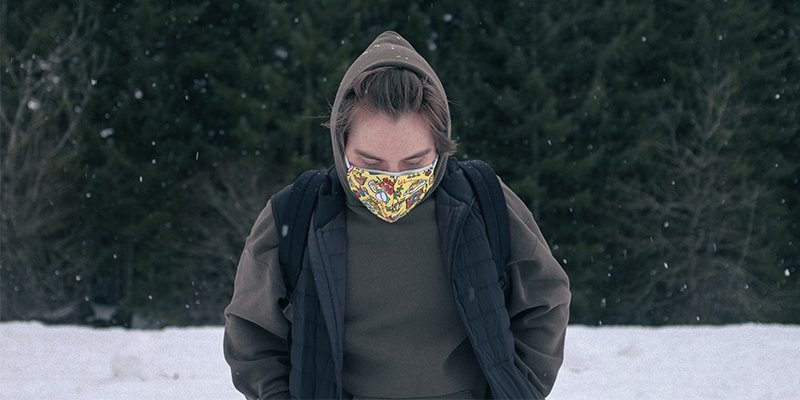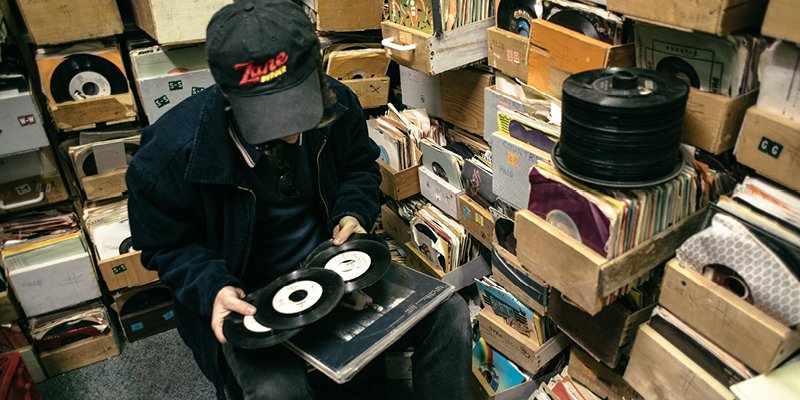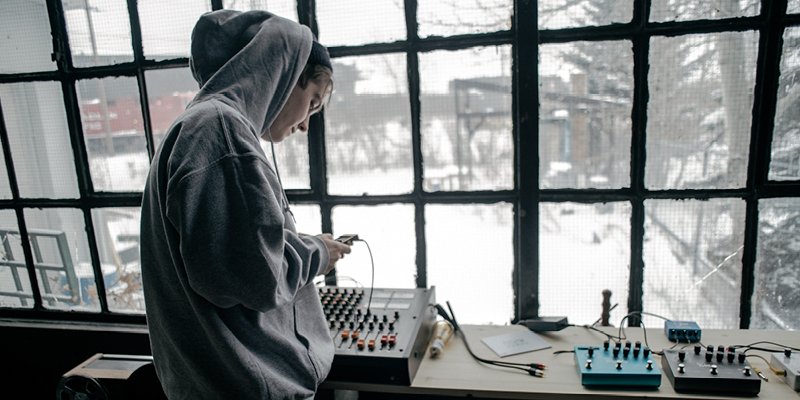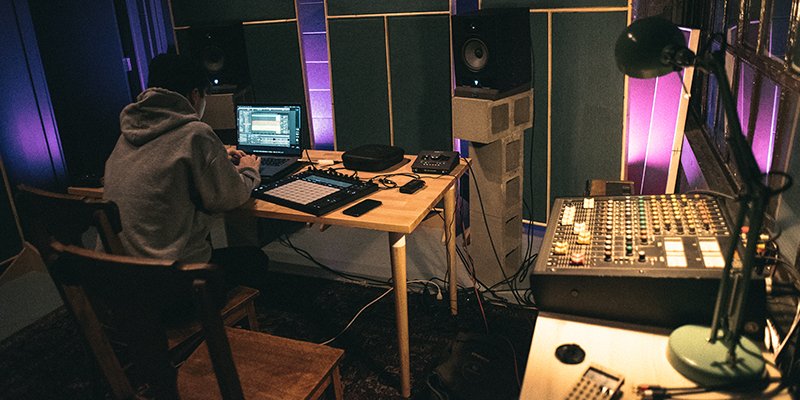Studies in Sound: Arbour on Lo-fi, Beats and Musical Exploration

Though primarily known for chill lo-fi beats and study beats playlists on YouTube and Spotify, the artist known as Arbour’s origins weren’t exactly auspicious. Like many electronic musicians, the Seattle-based artist (real name Hans Watkins) got his start on a decidedly modest setup. Eighteen years old at the time, and a freshman at Western Washington University, Watkins had at his disposal, along with Ableton Live, some garden-variety Logitech computer monitors, a MIDI keyboard, a microphone, and a plastic ukulele.
“I was making beats on Ableton, and that's when I decided to change my name [from Hans Audio] to Arbour,” Watkins recalls. “I don't even think I was using an interface at that time. I was just using my laptop and hacking beats out on the keyboard, you know?”
Initially, Watkins would record ukulele notes and chords, pitch them down, and add a ton of reverb. Guitar came a bit later, as did “little clicks and snaps” that he made on his desk and other surfaces. About a year later, Watkins moved into an apartment where he began acquiring more gear. One of the earliest pieces of kit he bought was a Roland SP-404.
“I spent my whole monthly budget on that 404 and ate peanut butter for a month,” Watkins says. “That changed a lot of things.” The 404 and Ableton Live served as both sketchbook and recording media with Watkins’ typical workflow being: make sounds in the 404, then augment and edit them in Live.
“I think since I got the 404, which was six years ago, I've been figuring out how to use hardware and software simultaneously,” he explains. “With the 404, I started sampling records and it's just so easy with RCA-in. So, I would go to the record shop and get the 99 cent vinyl and sample.”

Arbour gets his fingers dusty on the hunt for sample fodder
Wanting to post music on Spotify without wanting to deal with copyright issues, Watkins moved away from sampling, at least in his original music. It was also at this time that Watkins joined his university’s audio production program. Using his own Casio keyboard and the audio program’s studio gear, Watkins began recording external instruments into his 404, where he would “mangle” the sounds to create something different. From there, he would bring the sounds into Live, where additional edits were made.
An early self-titled Arbour production
While Watkin’s work under Arbour no longer features samples of other artists, he still samples for practice. And like artists such as Animal Collective and Boards of Canada, he’s gotten into the art of self-sampling.
“I don't know, I feel like that skill is really integral to beat making and I don't want to lose sight of that, so I try to keep up my chops,” says Watkins. “Now, when I come up with a really cool piano loop, I know what to do with it. I know how to chop it up because I've done it on other people's material. I think that’s important.”
Download Arbour’s free Sample Pack
Arbour wants to hear what you make with these samples. Tag him in your creations on Instagram (@prod_arbour) and he’ll be sure to check them all out!
The 404 Beats Scene

Arbour in his studio
In the realm of the SP-404, some artists loom large. There is of course the supreme practitioner of sampling, J Dilla, whose use of the 404’s predecessor, the Boss SP-303 has inspired hip hop and indie artists alike. The 404 is beloved by artists such as Animal Collective, Grimes, Toro y Moi, and James Blake. Even Radiohead’s Thom Yorke is known to have used it. Arbour himself came to the 404 through Soundcloud’s 404 beats scene.
“In 2012, the whole 404 beats scene was getting more popular on Soundcloud,” Watkins recalls. “I saw it as a subculture I wanted to be part of. I was listening to artists like [ bsd.u ], j^p^n, and this guy Trash McGoony (now [trash.goon), who I just loved,” he says. “He made these really dead simple but dark hip hop 404 beats.”
From there, Watkins began looking back at these artists’ influences. What he found were artists like Dilla, Madlib, Flying Lotus, Burial, and Four Tet. When Watkins listens to Nujabes and J Dilla, he says it really sobers him up to the type of beats he wants to make.
“I also have to mention James Blake – along with J Dilla and Nujabes, they're the three artists that I will go listen to when I need to be grounded,” says Watkins. “I feel like J Dilla gives me a feel for the drums, James Blake gives me that experimentation, and Nujabes is kind of the emotion I’m after.”
Arbour also credits the 404 with inspiring him to introduce more organic elements into his music; sounds that he could play with inside the 404 and Live.
When Watkins pivoted from his early Hans Audio recordings to Arbour, he recalls having a vision of what his music could be and the type of music he wanted to make. At the time, he was transitioning from dark dance music to something he considers “more organic sounding.”
It’s been a path that has seen him incorporate actual instruments and a more relaxing vibe, but always with a balance of light and shade. Often this has led to Watkins exploring ways to impart his music and sounds with a certain patina – one that listeners often interpret as lo-fi.
Craft Work
Arbour is known for beats, but in fact Watkins doesn’t start tracks with percussive elements. Instead, a tune usually comes into existence by way of melody and harmony. Chords and sound design go hand-in-hand, which then in turn, set the table for the beat. “I'll pull up an electric piano and try to mess with it, maybe pitch it down a little bit,” he explains. “I feel like that is when I usually add drums, and if it works then I know I've got the swing down, right? It just feels right then and I know it's going to be a song. And if it doesn't, then I pretty much just start over.”
On the rare occasions that Watkins starts with drums, he usually ends up pivoting to basslines. For him, it’s crucial to get the kick and bassline to sit right. From there, he adds melody and sound design elements.
When it comes to pitching down sounds, Watkins likes to record external instruments to audio, or bounce MIDI instruments to audio. To pitch it down, he uses Live’s Warp function. “I'm always trying to take a sound as it is originally and then mangle it in some way and then recover it,” says Watkins.
It is in these approaches that Burial’s influence on Watkin’s Arbour project is most apparent. The enigmatic London-based producer is well known among electronic music artists and listeners for his pitched vocals – often sampled from YouTube and video games like Metal Gear Solid – as well as intricate sound design.
“I would love to be able to make music in this strange way that Burial does,” says Watkins. “I don't know, from what I've heard, the way I make music is more methodical than his is, but I really aspire to his creative approach. It seems like he's so musical about the way he puts things together, even to the point of him using the software Sound Forge.”
“I've read a lot about him, like how he works with things off the grid, creating these grooves just by ear,” he adds. “And so sometimes I turn off the grid just to try to get in that mindset. I don’t know, I'm almost speechless when I try to think about the things that Burial does, but what I really am inspired by is his sonic universe. It’s the hollow reverb, r&b vocals, and fuzzy basslines that are so cool,” says Watkins. “I definitely try to create sounds that are kind of like his because it's just so interesting.”
Studies in Sound
Ideally, Watkins wants his music to occupy just as unique a place as Burial’s, musically speaking. And this means both subtle and drastic breaks from chill lo-fi sounds.
“I almost feel like I've been pigeonholed into being lo-fi, and I don't have too much of a problem with it,” Watkins says. “I see the similarities but I kind of try not to think about it too much because for a while I was thinking, oh, I'm making lo-fi hip-hop. A lot of that probably has to do with sampling, and artists that you choose to sample as well as the drums you select.”
“Sometimes I feel that my music isn’t very lo-fi, and it's not really hip hop either,” he says. “I feel like the most accurate way to describe my stuff is that it's just beats. They're just beats and they go in a lot of different directions. Sometimes they're really relaxing and sometimes they’re really evil sounding. I think there are a lot of different ways that it goes.”

Arbour at his Inner Ocean studio
For his own sake, Watkins tries not to over-categorize his music. If he does get too concerned with categorization, he quickly finds himself in a creative rut. Watkins is far more interested in becoming technically better at his craft. For instance, in the last year he has been taking jazz piano lessons.
“I think that one thing that really unites a lot of different listeners, people who would call themselves ‘lo-fi hip hop,’ or people who would say, ‘it's just beats,’ is an appreciation for jazz,” Watkins muses.
What led Watkins back to jazz was hearing the unexpected in his own music. He occasionally found himself stumbling across good turnarounds in rather simple chord progressions. These turnarounds didn’t quite make sense to him, but he knew they sounded good, and felt the desire to investigate the why of it. The source of these happy accidents, as Joy of Painting host Bob Ross was fond of saying, was in jazz.
Revisiting jazz also led Watkins to thinking about recording techniques and musical arrangements of the 1960s and 1970s and how to apply those elements within Arbour compositions. “I feel like I've always thought it was really cool when things sound old,” Watkins says. “You listen to an old record and it's really dusty, has a lot of character, and they also just arranged things really differently back then. So, learning about those types of arrangements, and then also knowing how to process it and record it in a similar way is kind of interesting.”
“Now, I feel like there are two sides of this whole jazz idea: the musical arrangement and the technical side, and then there is literally the production and recording of the records from that time,” he explains. “I’m interested in taking all of that and then crumpling it up with all the new technology we have and seeing what we get.”
Watkins is uncertain about where all of this will lead him musically. Nevertheless, he wants to incorporate the approaches into his musical workflow. “I would like to become a better jazz musician, so that when I sit down and make beats there’s a little bit more musicality going on,” he says. “A little more to chew on.”
The Scene is Online
It’s clear that Watkins is part of a burgeoning online musical phenomenon – the “chill beats” scene. Watkins admits that there really isn’t a concrete IRL chill beats scene, even though he has been collaborating with some local Seattle musicians.
“I feel like it's gotten really weird with Covid-19 because I would say I was a part of a local scene but now no one is a part of a local scene,” Watkins says. “However, I do feel closer to a group of musicians I know from New York, and I feel that Covid has made the distances between people not so far away.”
“I don't think of them as being so distant,” he adds. “I don't know, maybe it sounds a little poetic but the local scene is online now. And I feel like we're all equally close, which is kind of cool. But I do miss in-person sessions.”
Given the beats scene’s popularity, Watkins would like to see some shows organized after the pandemic is under control. In fact, right before Covid, he says a bunch of beats producers were going out and playing live.
“That was just kind of starting,” Watkins notes. “A lot of the people who I have kind of grown up making music with were starting to do these shows and getting huge crowds turning out, and then COVID struck. So, I am looking forward to that some day, and I guess maybe I'm incubating right now for the return of live shows.”
For now, Watkins is content building up a library of visuals for live shows, and further tapping into the online scene with his YouTube series Beats With Arbour. In these videos he breaks down his production process with the aim of engaging with what he calls the genre’s passive listening audience. “For the sake of clarity, I mean people who like to put on a playlist and listen to it as background sound – which I respect, as I'm a passive listener myself,” says Watkins. “Sometimes I feel like there are a lot of people who hear this synthetic music and even if they think it’s really nice, they don’t think much about it. But there is a lot that goes into it and it's actually really interesting.”
Beats With Arbour is a way for Watkins to showcase his unique sounds and how he gets them. But he also sees the series as a substitute for live music void of the last year. “I feel like it’s kind of hard to play beat sets live sometimes because you've recorded things and effected it so much that you can't exactly play it live the way that you might want to,” he says. “So, in a way, the production of these beats becomes the live show. I wanted to make people into more active listeners perhaps.”
“I speak from experience because I'm a really big fan of other other people's stuff,” he adds. “If I could see Burial’s studio or Flying Lotus’s or James Blake’s, it would be so cool. So, I want to create that feeling for people who listen to my music.”
Between Beats With Arbour, Watkins has been recording two forthcoming collections of songs. The first is an album he is readying for a January release, while the other set of songs could be either a few EPs or another full album. Watkins hasn’t yet settled on the format.
Beyond these new releases, Watkins is also about to start sifting through a gigabyte of musical odds and ends, as he calls them. He wants to find a place for all of his song fragments, and expects to both self-release some tracks and earmark others for label release in 2021.
“I have so many projects that haven't even made it into my ‘new songs’ folder, which is just full of a bunch of .WAVs I've exported,” says Watkins. “There are just so many different projects going on that I have a hard time organizing. We have too much time on our hands!”
Keep up with Arbour on his website and Instagram
Text and interview: DJ Pangburn